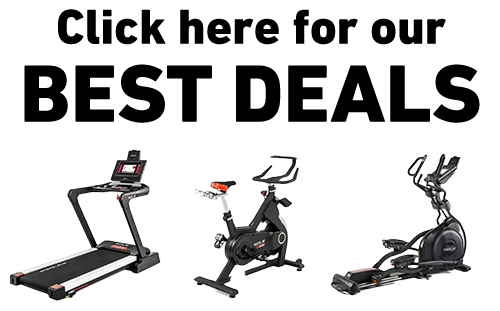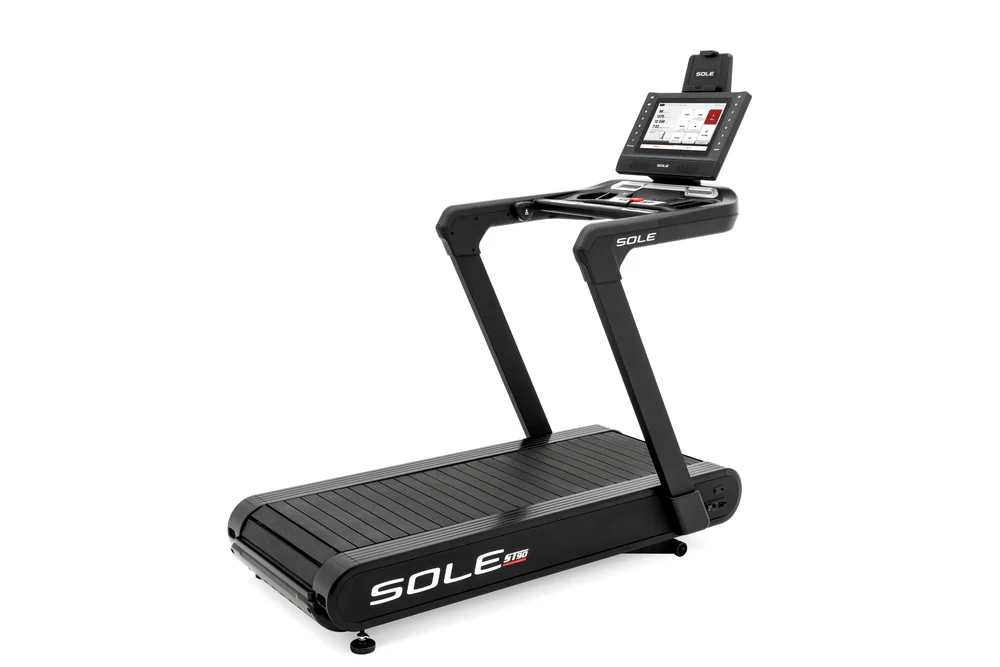Key Takeaways
- Always warm up before starting your elliptical workout to prevent knee injuries.
- Maintain proper form by keeping your knees aligned with your toes.
- Adjust the resistance and incline settings to suit your fitness level.
- Wear supportive shoes and consider using a knee brace for extra protection.
- Consult a healthcare professional if you experience persistent knee pain.
|
At SOLE Fitness, we’re proud to offer the best treadmills for your home or gym. These machines are crafted to meet the highest standards of quality and performance, ensuring they are ideal for anyone - from fitness novices to seasoned athletes. Featured Products SOLE Ellipticals: Priced from $1,199.99, SOLE ellipticals are known for their ergonomic design, durability, and affordability. They provide a quiet, smooth workout with intuitive consoles, adjustable stride lengths, incline options, and heart rate monitoring, ensuring a comprehensive exercise experience. |
Why Knee Protection Matters
Using an elliptical machine can be a fantastic way to get your cardio in without putting too much strain on your joints. However, knee protection is essential because the knees are complex joints that bear a lot of weight and stress during exercise. Overuse or improper use of an elliptical can lead to knee pain or even injury. Therefore, understanding the mechanics and taking preventative measures can save you from discomfort and long-term damage.
Warm-Up Techniques
Warming up is non-negotiable if you want to protect your knees - a good warm-up increases blood flow to your muscles and prepares your joints for the workout ahead. Here’s how you can warm up effectively:
- Start with 5-10 minutes of light cardio, like walking or slow jogging.
- Perform dynamic stretches, such as leg swings and hip circles.
- Include some bodyweight exercises like squats and lunges to activate your leg muscles.
Proper Elliptical Form
Maintaining proper form on the elliptical is crucial for protecting your knees. Here are some tips to keep in mind:
- Keep your knees aligned with your toes to avoid unnecessary strain.
- Stand upright and avoid leaning forward or backward.
- Engage your core to help stabilize your body.
Most importantly, listen to your body. If you feel any discomfort in your knees, it may be a sign that your form needs adjustment.

Core Engagement Tips
Engaging your core muscles can significantly reduce the strain on your knees - a strong core provides better stability and balance, which helps in maintaining proper form. Here are some ways to engage your core:
- Keep your abdominal muscles tight throughout the workout.
- Focus on maintaining a neutral spine.
- Incorporate core-strengthening exercises into your routine, such as planks and bicycle crunches.

Adjusting Elliptical Settings
Choosing the Right Resistance
Resistance is key to an effective workout, but too much resistance can put undue stress on your knees. Start with a lower resistance setting and gradually increase it as your strength improves: this approach ensures that your muscles are adequately challenged without compromising your knee health.
Optimum Incline Levels
The incline setting on an elliptical can simulate uphill walking or running, providing an extra challenge; however, a steep incline can strain your knees. Therefore, it's best to start with a low or moderate incline and adjust it as you become more comfortable.
At SOLE, our ellipticals come with varying resistance and incline levels that you can adjust to suit your goals.
- E25: 20 lbs flywheel weight, 20 resistance levels, 20 incline levels
- E35: 25 lbs flywheel weight, 20 resistance levels, 20 incline levels
- E95: 27 lbs flywheel weight, 20 resistance levels, 20 incline levels
- E95S: 30 lbs flywheel weight, 20 resistance levels, N/A incline levels
- E98: 32 lbs flywheel weight, 40 resistance levels, 20 incline levels
Stride Length Adjustments
Stride length is another important setting to consider - a stride that’s too long or too short can lead to improper form and knee pain. Most modern ellipticals, like the SOLE E95S, offer adjustable stride lengths to accommodate different users. Find a stride length that feels natural and allows you to maintain proper form.
Equipment and Accessories
Best Shoes for Support
Wearing the right shoes is crucial when using an elliptical, so you need to look for shoes that offer good arch support, cushioning, and a snug fit. Running shoes are often a good choice because they are designed to absorb impact and provide stability. Make sure to replace your shoes every 300-500 miles to maintain optimal support.

Using a Knee Brace
If you have a history of knee issues or are recovering from an injury, using a knee brace can provide additional support and stability. Knee braces help to distribute pressure evenly across the joint and can reduce the risk of further injury, so choose a brace that fits well and does not restrict your range of motion.
Post-Workout Care
Effective Cool Down Exercises
Cooling down is just as important as warming up - it helps to gradually bring your heart rate back to normal and reduces muscle stiffness. Here are some effective cool down exercises:
- Slow down your elliptical pace for 5-10 minutes before stopping completely.
- Perform static stretches, focusing on your legs and lower body.
- Include gentle yoga poses like Child’s Pose and Downward Dog to stretch and relax your muscles.
These cool down exercises will help your muscles recover faster and reduce the risk of knee pain.
Stretching Routines
Regular stretching can improve flexibility and reduce tension in your muscles, which is beneficial for knee health. Incorporate these stretches into your routine:
- Quadriceps Stretch: Stand on one leg, pull the other foot towards your buttocks, and hold for 20-30 seconds.
- Calf Stretch: Stand facing a wall, place one foot behind the other, and press your heel into the ground. Hold for 20-30 seconds.
- Hamstring Stretch: Sit on the floor with one leg extended and the other bent. Reach for your toes and hold for 20-30 seconds.

Perform these stretches after every workout to keep your muscles flexible and your knees protected.
When to Seek Help
Recognizing Pain Signals
It's important to differentiate between normal workout soreness and pain that signals a problem. Here are some signs that you should not ignore:
- Sharp or stabbing pain in the knee.
- Swelling or redness around the knee joint.
- Difficulty bearing weight on the affected leg.
- Pain that persists for more than a few days.
If you experience any of these symptoms, it's time to take a break and consult a healthcare professional.
Consulting a Professional
If you have persistent knee pain, consulting a healthcare professional is essential - they can diagnose the issue and recommend appropriate treatment such as physical therapy, medication, or changes to your workout routine. Don't ignore persistent pain; early intervention can prevent more serious problems down the line.
Protect Your Knees with SOLE Ellipticals
Protecting your knees while using an elliptical is crucial to prevent pain and long-term injury. Key steps include a thorough warm-up to prepare your joints and muscles, maintaining proper form, and engaging your core to provide stability. Adjusting the elliptical resistance, incline, and stride length settings can also help reduce knee strain. Wearing supportive shoes and considering additional accessories like knee braces further enhance protection.
SOLE ellipticals are designed with user safety and comfort in mind, featuring adjustable resistance, incline levels, and stride lengths to accommodate individual needs. By using a SOLE elliptical carefully and adhering to these knee protection strategies, you can enjoy a safer and more effective workout, ensuring that your fitness journey remains pain-free and productive.
Frequently Asked Questions (FAQ)
Is the elliptical safe for knees?
Yes, ellipticals are generally safe for knees as they provide a low-impact workout. However, proper form and settings are crucial to avoid strain.
How often should I use an elliptical?
You can use an elliptical 3-5 times a week, depending on your fitness level and goals. Make sure to include rest days to allow your knees to recover.
Can I use an elliptical if I have existing knee pain?
It's best to consult a healthcare professional before using an elliptical if you have existing knee pain. They can advise you on the best course of action.
What are the best warm-up exercises before using an elliptical?
Light cardio, dynamic stretches, and bodyweight exercises are excellent warm-up activities to prepare your knees for an elliptical workout.
Should I consult a doctor before starting elliptical workouts?
If you have any pre-existing conditions or concerns about your knees, it's a good idea to consult a doctor before starting elliptical workouts.



Leave a comment
This site is protected by hCaptcha and the hCaptcha Privacy Policy and Terms of Service apply.